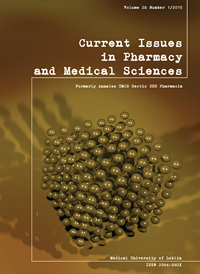Selected forms of therapy for individuals with autism spectrum disorder
DOI:
https://doi.org/10.1515/cipms-2015-0035Keywords:
autism spectrum disorder, therapy, pharmacological treatmentAbstract
Autism spectrum disorder (ASD) is a condition of multiple origins. It is characterised by a range of behaviour patterns, in addition to disturbed social and emotional functioning. Of note, early therapy is conducive to better treatment results. A few recently discussed therapies have a particularly positive impact on children with ASD. Corbett et al. [2] proposed Sense Theatre. This involves instilling appropriate behaviours and communication patterns into the afflicted individual through acting. Role-playing and other similar techniques also offer an opportunity for children with ASD to improve their areas of empathy and social cooperation. With regard to bio-feedback-related techniques, Friedrich et al. [3] was noted for developing the Brain-computer method, a system of game interface connected to an external device. The method targets the mirror neuron system (MNS) in order to enhance cognitive, emotional and behavioural functions through neurofeedback. An approach put forward by Solomon et al. [10] is called ‘Play and Language for Autistic Youngsters (PLAY) Project Home Consultation’. Herein, volunteers visit patients’ homes on a regular basis to engage the children in play and games, after which they discuss with parents, the issues that came up. The PLAY reduces guardians’ stress levels and improves children’s skills. A pharmacological method is that of administering sulphoraphane [9], which reduces damaging effects. As others claim [8,1,7], other dietary approaches prove efficient as well. In summation, an early intervention and the employment of a multimodal treatment approach can be of importance for enhancing the life of ASD-affected children.
References
1. Bent S., Bertoglio K., Hendren R.L.: Omega-3 Fatty Acids for Autistic Spectrum Disorder: A Systematic Review. J Autism Dev Disord., 39(8), 1145, 2009 [CrossRef]
2. Corbett B.A., Qualls L.R. Valencia B., Fecteau S.M., Swain D.M.: Peer-mediated theatrical engagement for improving reciprocal social interaction in autism spectrum disorder. Front Pediatr., 10, 110, 2014
3. Friedrich E.V.C., Suttie N., Sivanathan A., Lim T., Louchart S., Pineda J.A.: Brain-computer interface game applications for combined neurofeedback and biofeedback treatment for children on the autism spectrum. Front Neuroeng., 3, 7, 21, 2014
4. Komender J., Jagielska G., Bryńska A., editors (2012). Autyzm i zespoł Aspergera. Warszawa: Wydawnictwo Lekarskie PZWL; p. 17.
5. Ling-Yi Y.: Quality of life of Taiwanese adults with autism spectrum disorder. PLoS One, 9,9,10, 2014.
6. Mazza M., Pino M.C., Mariano M., Tempesta D., FerraraM., De Berardis D, Masedu F., Valenti M.: Affective and cognitive empathy in adolescents with autism spectrum disorder. Front Hum. Neurosci., 8, 2014.
7. Millward C., Ferriter M., Calver S. J., Connell-Jones G.G.: Glutenand casein-free diets for autistic spectrum disorder. Cochrane Database Syst. Rev., 2008; (2): CD003498. [Web of Science]
8. Napoli E., Duenas N., Giulivi C.: Potential Therapeutic Use of the Ketogenic Diet in Autism Spectrum Disorders. Front Pediatr.,2, 2014.
9. Singh K., Connors S.L., Macklin E.A., Smith K.D., Fahey J.W., Talalay P., Zimmermana A.W.: Sulforaphane treatment of autism spectrum disorder (ASD). Proc. Natl. Acad. Sci. USA, 111, 43, 15550, 2014. [CrossRef]
10. Solomon R.,Van Egeren L.A., Mahoney G., Quon Huber M. S., Zimmerman P.: PLAY Project Home Consultation Intervention Program for Young Children With Autism Spectrum Disorders: A Randomized Controlled Trial. J Dev BehavPediatr., 35(8), 475, 2014
11. Weitlauf A.S., Mc Pheeters M.L., Peters B., Sathe N., Travis R.,Aiello R., Williamson E., Veenstra-VanderWeele J., Krishnaswami S., Jerome R., Warren Z.: Therapies for children with autism spectrum disorder. Behavioral Interventions Update. Agency for Healthcare Research and Quality (US), Comparative Effectiveness Review, 137, 2014.
Downloads
Published
Issue
Section
License
Copyright (c) 2015 Authors

This work is licensed under a Creative Commons Attribution-NonCommercial-NoDerivatives 3.0 Unported License.


